Schools Can Opt Out Of Serving Pink Slime In School Lunches, USDA Says

Mystery meat in school cafeterias across the U.S. may become a little less mysterious.
The U.S. Department of Agriculture announced Thursday that schools can opt out of serving what critics call pink slime - a mixture of ground beef trimmings washed in ammonium.
USDA officials still approve of serving the controversial mystery meat in schools, but starting in the fall 2012 semester, schools will be able to choose between serving either 95 percent lean ground beef with pink slime or fattier ground beef without it.
In 2011, several fast food restaurants banned pink slime due to growing pressure from consumer groups.
Pink slime -- or, as the industry would rather we call it, Lean Finely Textured Beef -- is an ingredient made from fatty pieces of meat left over after cutting away steaks and other prime cuts. The pieces are spun in a centrifuge to separate meat and fat and then mixed with ammonia to kill bacteria.
Since the early 1990s, Lean Finely Textured Beef has been allowed as a component of the ground beef purchased by USDA for distribution through the [National School Lunch Program], Aaron Lavallee, a spokesman for the USDA, wrote in an email. However, no serving of beef could contain more than 15 percent pink slime.
Schools made it clear they want to be able to choose what students are served, an unnamed USDA source told The Associated Press.
School districts have made requests and school districts want, basically, choice, the source told the AP. And we respect that, they're our customers.
The USDA is contracted to buy 111 million pounds of ground beef for the National School Lunch Program, including 7 million pounds of lean finely textured beef. Schools will have the option to choose which meat they want to use once the contracts expire in the fall.
Critics of pink slime point to a 2009 New York Times article which says the process of using ammonia to decontaminate the meat is ineffective and to a TV episode of Jamie Oliver's Food Revolution in which chef Jamie Oliver called it dog food.
An online petition to stop pink slime from being used in schools now has more than 225,000 signatures.
Even apart from safety concerns, it is simply wrong to feed our children connective tissues and beef scraps that were, in the past, destined for use in pet food and rendering and were not considered fit for human consumption, Bettina Siegel, petition creator and blogger, wrote in the petition.
Beef Products Inc., the makers of pink slime, deny that the meat in inedible on its website, PinkSlimeIsAMyth.com.
Boneless lean beef trimmings are 100% edible meat, the company wrote. These trimmings are simply the lean beef removed from the meat and fat that is trimmed away when beef is cut into steaks and roasts. No process exists that could somehow make an inedible meat edible.
The USDA also continues to support lean finely textured beef.
USDA only purchases products for the school lunch program that are safe, nutritious and affordable -- including all products containing Lean Finely Textured Beef, it said in a statement.
The USDA also urges customers to consult science-based information on the safety and quality of this product.
But the science shows that pink slime is dangerous, Gerald Zirnstein, a former USDA microbiologist turned whistleblower, told the Daily.
They've taken a processed product, without labeling it, and added it to raw ground beef, Zirnstein said. Science is the truth, and pink slime at this point in time is a fraudulent lie.
© Copyright IBTimes 2024. All rights reserved.





















